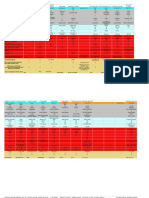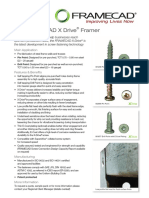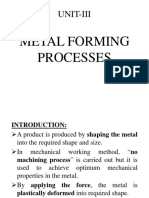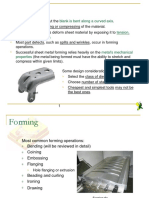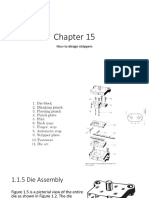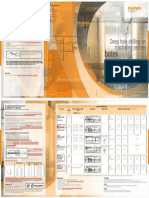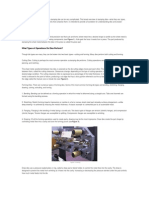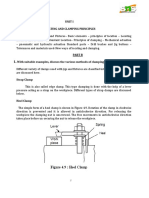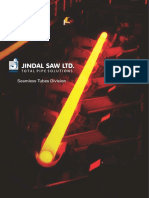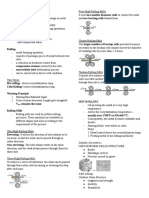Sheet Metal Forming
Sheet Metal Forming
Uploaded by
Khin Aung ShweCopyright:
Available Formats
Sheet Metal Forming
Sheet Metal Forming
Uploaded by
Khin Aung ShweCopyright
Available Formats
Share this document
Did you find this document useful?
Is this content inappropriate?
Copyright:
Available Formats
Sheet Metal Forming
Sheet Metal Forming
Uploaded by
Khin Aung ShweCopyright:
Available Formats
07/06/2015
SheetMetalForming
Login|Registerforfree!
Home
Estimators
Parts
Widgets
Processes
Materials
Suppliers
Metalcuttingservices
Goodfinishing&reasonablepriceEnquirenow
Overviews
Processes
PolymerProcessing
BlowMolding
InjectionMolding
MetalInjectionMolding
Thermoforming
SheetMetalForming
Sheet metal forming processes are those in which force is applied to a
piece of sheet metal to modify its geometry rather than remove any
material. The applied force stresses the metal beyond its yield strength,
causingthematerialtoplasticallydeform,butnottofail.Bydoingso,the
sheet can be bent or stretched into a variety of complex shapes. Sheet
metalformingprocessesincludethefollowing:
MetalCasting
CentrifugalCasting
DieCasting
InvestmentCasting
PermanentMold
SandCasting
ShellMoldCasting
Machining
Milling
Turning
Holemaking
DrillSizeChart
Bending
Rollforming
Spinning
DeepDrawing
Stretchforming
ImportSteel
Sheets
FindGlobalBuyersand
Importers.Connectyour
potentialcustomers.
Returntotop
Bending
Bendingisametalformingprocessinwhichaforceisappliedtoapieceofsheetmetal,causingittobendat
anangleandformthedesiredshape.Abendingoperationcausesdeformationalongoneaxis,butasequence
ofseveraldifferentoperationscanbeperformedtocreateacomplexpart.Bentpartscanbequitesmall,such
asabracket,orupto20feetinlength,suchasalargeenclosureorchassis.Abendcanbecharacterizedby
severaldifferentparameters,shownintheimagebelow.
TapSizeChart
SheetMetalFabrication
Forming
Cuttingwithshear
Cuttingwithoutshear
GaugeSizeChart
AdditiveFabrication
SLA
FDM
SLS
DMLS
3DPrinting
InkjetPrinting
JettedPhotopolymer
LOM
Materials
Metals
Plastics
CaseStudies
CostAnalysis
PartRedesign
ProductDevelopment
Resources
http://www.custompartnet.com/wu/sheetmetalforming#bending
BendingDiagram
1/9
07/06/2015
SheetMetalForming
CurriculumResources
Glossary
BendlineThestraightlineonthesurfaceofthesheet,oneithersideofthebend,thatdefinestheendof
thelevelflangeandthestartofthebend.
OutsidemoldlineThestraightlinewheretheoutsidesurfacesofthetwoflangeswouldmeet,werethey
tocontinue.Thislinedefinestheedgeofamoldthatwouldboundthebentsheetmetal.
FlangelengthThelengthofeitherofthetwoflanges,extendingfromtheedgeofthesheetto the bend
line.
MoldlinedistanceThedistancefromeitherendofthesheettotheoutsidemoldline.
Setback The distance from either bend line to the outside mold line. Also equal to the difference
betweenthemoldlinedistanceandtheflangelength.
BendaxisThestraightlinethatdefinesthecenteraroundwhichthesheetmetalisbent.
BendlengthThelengthofthebend,measuredalongthebendaxis.
Bend radius The distance from the bend axis to the inside surface of the material, between the bend
lines.Sometimesspecifiedastheinsidebendradius.Theoutsidebendradiusisequaltotheinsidebend
radiusplusthesheetthickness.
BendangleTheangleofthebend,measuredbetweenthebentflangeanditsoriginalposition,orasthe
includedanglebetweenperpendicularlinesdrawnfromthebendlines.
BevelangleThecomplimentaryangletothebendangle.
The act of bending results in both tension and compression in the sheet metal. The outside portion of the
sheet will undergo tension and stretch to a greater length, while the inside portion experiences compression
and shortens. The neutral axis is the boundary line inside the sheet metal, along which no tension or
compressionforcesarepresent.Asaresult,thelengthofthisaxisremainsconstant.Thechangesinlength
to the outside and inside surfaces can be related to the original flat length by two parameters, the bend
allowanceandbenddeduction,whicharedefinedbelow.
NeutralAxis
NeutralaxisThelocationinthesheetthatisneitherstretchednorcompressed,andthereforeremainsat
aconstantlength.
Kfactor The location of the neutral axis in the material, calculated as the ratio of the distance of the
neutralaxis(measuredfromtheinsidebendsurface)tothematerialthickness.TheKfactorisdependent
uponseveralfactors(material,bendingoperation,bendangle,etc.)andistypicallygreaterthan0.25,but
cannotexceed0.50.
BendallowanceThelengthoftheneutralaxisbetweenthebendlines,orinotherwords,thearclength
ofthebend.Thebendallowanceaddedtotheflangelengthsisequaltothetotalflatlength.
BenddeductionAlsocalledthebendcompensation,theamountapieceofmaterialhasbeenstretched
bybending.Thevalueequalsthedifferencebetweenthemoldlinelengthsandthetotalflatlength.
Whenbendingapieceofsheetmetal,theresidualstressesinthematerialwillcausethesheettospringback
slightly after the bending operation. Due to this elastic recovery, it is necessary to overbend the sheet a
preciseamounttoachievethedesiredbendradiusandbendangle.Thefinalbendradiuswillbegreaterthan
http://www.custompartnet.com/wu/sheetmetalforming#bending
2/9
07/06/2015
SheetMetalForming
initially formed and the final bend angle will be smaller. The ratio of the final bend angle to the initial bend
angle is defined as the springback factor, KS. The amount of springback depends upon several factors,
includingthematerial,bendingoperation,andtheinitialbendangleandbendradius.
Springback
Bending is typically performed on a machine called a press brake, which can be manually or automatically
operated.Forthisreason,thebendingprocessissometimesreferredtoaspressbrakeforming.Pressbrakes
areavailablein a range of sizes (commonly 20200 tons) in order to best suit the given application. A press
brakecontainsanuppertoolcalledthepunchandalowertoolcalledthedie,betweenwhichthe sheet metal
islocated.Thesheetiscarefullypositionedoverthedieandheldinplacebythebackgaugewhilethepunch
lowers and forces the sheet to bend. In an automatic machine, the punch is forced into the sheet under the
powerofahydraulicram.Thebendangleachievedisdeterminedbythedepthtowhichthepunchforcesthe
sheet into the die. This depth is precisely controlled to achieve the desired bend. Standard tooling is often
usedforthepunchanddie,allowingalowinitialcostandsuitabilityforlowvolumeproduction.Customtooling
canbeusedforspecializedbendingoperationsbutwilladdtothecost.Thetoolingmaterialischosenbased
upon the production quantity, sheet metal material, and degree of bending. Naturally, a stronger tool is
requiredtoendurelargerquantities,hardersheetmetal,andseverebendingoperations.Inorderofincreasing
strength,somecommontoolingmaterialsincludehardwood,lowcarbonsteel,toolsteel,andcarbidesteel.
http://www.custompartnet.com/wu/sheetmetalforming#bending
3/9
07/06/2015
SheetMetalForming
PressBrake(Open)
PressBrake(Closed)
While using a press brake and standard die sets, there are still a variety of techniques that can be used to
bend the sheet. The most common method is known as Vbending, in which the punch and die are "V"
shaped.Thepunchpushesthesheetintothe"V"shapedgrooveintheVdie,causingittobend.Ifthepunch
does not force the sheet to the bottom of the die cavity, leaving space or air underneath, it is called "air
bending".Asaresult,theVgroovemusthaveasharperanglethantheanglebeingformedinthesheet.Ifthe
punchforcesthesheettothebottomofthediecavity,itiscalled"bottoming".Thistechniqueallowsformore
controlovertheanglebecausethereislessspringback.However,ahighertonnagepressisrequired.Inboth
techniques,thewidthofthe"V"shapedgroove,ordieopening,istypically6to18timesthesheetthickness.
Thisvalueisreferredtoasthedieratioandisequaltothedieopeningdividedbythesheetthickness.
http://www.custompartnet.com/wu/sheetmetalforming#bending
4/9
07/06/2015
SheetMetalForming
VBending
InadditiontoVbending,anothercommonbendingmethodiswipe bending, sometimes called edge bending.
Wipebendingrequiresthesheettobeheldagainstthewipediebyapressurepad.Thepunchthen presses
againsttheedgeofthesheetthatextendsbeyondthedieandpad.Thesheetwillbendagainsttheradiusof
theedgeofthewipedie.
WipeBending
Designrules
Bend location A bend should be located where enough material is present, and preferably with straight
edges,forthesheettobesecuredwithoutslipping.Thewidthofthisflangeshouldbeequaltoatleast4
timesthesheetthicknessplusthebendradius.
Bendradius
Useasinglebendradiusforallbendstoeliminateadditionaltoolingorsetups
Insidebendradiusshouldequalatleastthesheetthickness
Bend direction Bending hard metals parallel to the rolling direction of the sheet may lead to fracture.
Bendingperpendiculartotherollingdirectionisrecommended.
Anyfeatures,suchasholesorslots,locatedtooclosetoabendmaybedistorted.Thedistanceofsuch
featuresfromthebendshouldbeequaltoatleast3timesthesheetthicknessplusthebendingradius.
In the case of manual bending, if the design allows, a slot can be cut along the bend line to reduce the
manualforcerequired.
Returntotop
http://www.custompartnet.com/wu/sheetmetalforming#bending
5/9
07/06/2015
SheetMetalForming
Rollforming
Rollforming,sometimesspelledrollforming,isametalformingprocessinwhichsheetmetal is progressively
shaped through a series of bending operations. The process is performed on a roll forming line in which the
sheetmetalstockisfedthroughaseriesofrollstations.Eachstationhasaroller,referredtoasarollerdie,
positioned on both sides of the sheet. The shape and size of the roller die may be unique to that station, or
several identical roller dies may be used in different positions. The roller dies may be above and below the
sheet, along the sides, at an angle, etc. As the sheet is forced through the roller dies in each roll station, it
plastically deforms and bends. Each roll station performs one stage in the complete bending of the sheet to
form the desired part. The roller dies are lubricated to reduce friction between the die and the sheet, thus
reducing the tool wear. Also, lubricant can allow for a higher production rate, which will also depend on the
material thickness, number of roll stations, and radius of each bend. The roll forming line can also include
othersheetmetalfabricationoperationsbeforeoraftertherollforming,suchaspunchingorshearing.
RollFormingLine
The roll forming process can be used to form a sheet into a wide variety of crosssection profiles. An open
profile is most common, but a closed tubelike shape can be created as well. Because the final form is
achievedthroughaseriesofbends,thepartdoesnotrequireauniformorsymmetriccrosssectionalong its
length. Roll forming is used to create very long sheet metal parts with typical widths of 120 inches and
thicknesses of 0.0040.125 inches. However wider and thicker sheets can be formed, some up to 5 ft. wide
and 0.25 inches thick. The roll forming process is capable of producing parts with tolerances as tight as
0.005inches.Typicalrollformedpartsincludepanels,tracks,shelving,etc.Thesepartsarecommonlyused
inindustrialandcommercialbuildingsforroofing,lighting,storageunits,andHVACapplications.
Returntotop
Spinning
Spinning,sometimescalledspinforming,isametalformingprocessusedtoformcylindricalpartsbyrotating
apieceofsheetmetalwhileforcesareappliedtooneside.Asheetmetaldiscisrotatedathighspeedswhile
rollers press the sheet against a tool, called a mandrel, to form the shape of the desired part. Spun metal
partshavearotationallysymmetric,hollowshape,suchasacylinder,cone,orhemisphere.Examplesinclude
cookware,hubcaps,satellitedishes,rocketnosecones,andmusicalinstruments.
SpinningistypicallyperformedonamanualorCNClatheandrequiresablank,mandrel,androllertool.The
blankisthediscshapedpieceofsheetmetalthatisprecutfromsheetstockandwillbeformedintothepart.
Themandrelisasolidformoftheinternalshapeofthepart,againstwhichtheblankwillbepressed.For more
complex parts, such as those with reentrant surfaces, multipiece mandrels can be used. Because the
mandreldoesnotexperiencemuchwearinthisprocess,itcanbemadefromwoodorplastic.However,high
volume production typically utilizes a metal mandrel. The mandrel and blank are clamped together and
securedbetween the headstock and tailstock of the lathe to be rotated at high speeds by the spindle. While
the blank and mandrel rotate, force is applied to the sheet by a tool, causing the sheet to bend and form
around the mandrel. The tool may make several passes to complete the shaping of the sheet. This tool is
usuallyarollerwheelattachedtoalever.Rollersareavailableindifferentdiametersandthicknessesandare
usually made from steel or brass. The rollers are inexpensive and experience little wear allowing for low
volumeproductionofparts.
http://www.custompartnet.com/wu/sheetmetalforming#bending
6/9
07/06/2015
SheetMetalForming
SpinningLathe
There are two distinct spinning methods, referred to as conventional spinning and shear spinning. In
conventionalspinning,therollertoolpushesagainsttheblankuntilitconformstothecontourof the mandrel.
Theresultingspunpartwillhaveadiametersmallerthantheblank,butwillmaintainaconstantthickness.In
shearspinning,therollernotonlybendstheblankagainstthemandrel,italsoappliesadownwardforcewhile
itmoves,stretchingthematerialoverthemandrel.Bydoingso,theouterdiameterofthespunpartwillremain
equaltotheoriginalblankdiameter,butthethicknessofthepartwallswillbethinner.
ConventionalSpinningvs.ShearSpinning
Returntotop
DeepDrawing
Deepdrawingisametalformingprocessinwhichsheetmetalisstretchedintothedesiredpartshape.Atool
pushesdownwardonthesheetmetal,forcingitintoadiecavityintheshapeofthedesiredpart.The tensile
forces applied to the sheet cause it to plastically deform into a cupshaped part. Deep drawn parts are
characterizedbyadepthequaltomorethanhalfofthediameterofthepart.Thesepartscanhaveavarietyof
cross sections with straight, tapered, or even curved walls, but cylindrical or rectangular parts are most
common. Deep drawing is most effective with ductile metals, such as aluminum, brass, copper, and mild
steel. Examples of parts formed with deep drawing include automotive bodies and fuel tanks, cans, cups,
kitchensinks,andpotsandpans.
Thedeepdrawingprocessrequiresablank,blankholder,punch,anddie.Theblankisapieceofsheetmetal,
typicallyadiscorrectangle,whichisprecutfromstockmaterialandwillbeformedintothepart.Theblankis
http://www.custompartnet.com/wu/sheetmetalforming#bending
7/9
07/06/2015
SheetMetalForming
clamped down by the blank holder over the die, which has a cavity in the external shape of the part. A tool
calledapunchmovesdownwardintotheblankanddraws,orstretches,thematerialintothediecavity.The
movementofthepunchisusuallyhydraulicallypoweredtoapplyenoughforcetotheblank.Boththedieand
punch experience wear from the forces applied to the sheet metal and are therefore made from tool steel or
carbon steel. The process of drawing the part sometimes occurs in a series of operations, called draw
reductions. In each step, a punch forces the part into a different die, stretching the part to a greater depth
eachtime.Afterapartiscompletelydrawn,thepunchandblankholdercanberaisedandthepartremoved
from the die. The portion of the sheet metal that was clamped under the blank holder may form a flange
aroundthepartthatcanbetrimmedoff.
DeepDrawing
DeepDrawingSequence
Returntotop
StretchForming
http://www.custompartnet.com/wu/sheetmetalforming#bending
8/9
07/06/2015
SheetMetalForming
Stretch forming is a metal forming process in which a piece of sheet metal is stretched and bent
simultaneously over a die in order to form large contoured parts. Stretch forming is performed on a stretch
press,inwhichapieceofsheetmetalissecurelygrippedalongitsedgesbygrippingjaws.Thegrippingjaws
areeachattachedtoacarriagethatispulledbypneumaticorhydraulicforcetostretchthesheet.Thetooling
usedinthisprocessisastretchformblock,calledaformdie,whichisasolidcontouredpieceagainstwhich
thesheetmetalwillbepressed.Themostcommonstretchpressesareorientedvertically,inwhichthe form
dierestsonapresstablethatcanberaisedintothesheetbyahydraulicram.Astheformdieisdriveninto
thesheet,which is gripped tightly at its edges, the tensile forces increase and the sheet plastically deforms
intoanewshape.Horizontalstretchpressesmounttheformdiesidewaysonastationarypresstable,while
thegrippingjawspullthesheethorizontallyaroundtheformdie.
StretchForming
Stretch formed parts are typically large and possess large radius bends. The shapes that can be produced
vary from a simple curved surface to complex nonuniform cross sections. Stretch forming is capable of
shaping parts with very high accuracy and smooth surfaces. Ductile materials are preferable, the most
commonly used being aluminum, steel, and titanium. Typical stretch formed parts are large curved panels
such as door panels in cars or wing panels on aircraft. Other stretch formed parts can be found in window
framesandenclosures.
Returntotop
AboutCustomPartNet
AboutUs
ContactUs
PrivacyPolicy
ListYourCompany
Advertise
ProcessOverviews
InjectionMolding
SandCasting
Milling
DieCasting
Glossary
CostEstimators
InjectionMoldingEstimator
MachiningEstimator
DieCastingEstimator
SandCastingEstimator
...seeallestimators
Widgets
SpeedandFeedCalculator
DrillSize/TapSizeChart
ClampingForceCalculator
Volume/WeightCalculator
...seeallwidgets
Copyright2009CustomPartNet.AllRightsReserved.
http://www.custompartnet.com/wu/sheetmetalforming#bending
9/9
You might also like
- Seamless steel tubes for structural purposes (结构用无缝钢管) : National Standard of the People's Republic of ChinaDocument25 pagesSeamless steel tubes for structural purposes (结构用无缝钢管) : National Standard of the People's Republic of ChinaJignesh Suthar100% (1)
- HMT Mandrel Bending 101Document80 pagesHMT Mandrel Bending 101zaiofracassadoNo ratings yet
- BS 1408-1964Document14 pagesBS 1408-1964Deepak J100% (1)
- GBT 14976-2012 English VersionDocument21 pagesGBT 14976-2012 English VersionNguyễn Xuân TrườngNo ratings yet
- Splines: Side Splines For Soft Holes in Fittings-Sae J499aDocument4 pagesSplines: Side Splines For Soft Holes in Fittings-Sae J499amanu100% (1)
- Sheet Metal Shearing and Bending: Training ObjectiveDocument6 pagesSheet Metal Shearing and Bending: Training ObjectiveLovely RainNo ratings yet
- Diamond and CBN WheelsDocument22 pagesDiamond and CBN WheelsM. Aguiar100% (1)
- Dynamic Mill Database - DATABASEDocument6 pagesDynamic Mill Database - DATABASERocco VersaceNo ratings yet
- Forging and Press 1Document18 pagesForging and Press 1Sumedh sonawane100% (1)
- Custom Three Post Progressive Stamping Die Design With Feeder CoilerDocument3 pagesCustom Three Post Progressive Stamping Die Design With Feeder CoilerSIMONENo ratings yet
- Roll FormingDocument2 pagesRoll FormingMujjo SahbNo ratings yet
- Press Tool Master FileDocument199 pagesPress Tool Master FileVishal ShindeNo ratings yet
- Frame Cad-Self Tapping Screw SpecDocument2 pagesFrame Cad-Self Tapping Screw Specersivaraj100% (1)
- Module Gear DataDocument2 pagesModule Gear DataMuhammad HaiderNo ratings yet
- Drill BitsDocument23 pagesDrill BitsIndah CharismasariNo ratings yet
- Marking ToolsDocument14 pagesMarking ToolsFabian NdegeNo ratings yet
- Avdel Threaded Inserts enDocument28 pagesAvdel Threaded Inserts enkamaleshaiahNo ratings yet
- Unit IIIDocument114 pagesUnit IIIManoj Kumar SNo ratings yet
- Die FormingDocument4 pagesDie FormingMohit KambojNo ratings yet
- ToolingDocument12 pagesToolingPuneet SharmaNo ratings yet
- Sheet Matel CalculationsDocument8 pagesSheet Matel CalculationsAbhinashNo ratings yet
- Dies1 2Document23 pagesDies1 2Ajay BabuNo ratings yet
- 14 StipperDocument33 pages14 Stippermahdi sakhaeeNo ratings yet
- SKF Ball ScrewDocument40 pagesSKF Ball Screwsav33No ratings yet
- Claw Pole Forging ProcessDocument8 pagesClaw Pole Forging ProcessBhagat SinghNo ratings yet
- Technical Plan For Roll Forming Machine: Model: WLFM40-250-1000Document5 pagesTechnical Plan For Roll Forming Machine: Model: WLFM40-250-1000ibrahimadiop1No ratings yet
- Split Cavity and Side CoreDocument29 pagesSplit Cavity and Side CoreShubham ChoudhariNo ratings yet
- Metal Bending: Bending Is A Manufacturing Process That Produces A V-Shape, U-Shape, or ChannelDocument12 pagesMetal Bending: Bending Is A Manufacturing Process That Produces A V-Shape, U-Shape, or ChannelMizero AimeNo ratings yet
- Design Analysis and Overview of Press Tool With Its Defects and RemediesDocument10 pagesDesign Analysis and Overview of Press Tool With Its Defects and Remediesh_eijy2743No ratings yet
- K-Factor - SheetMetal PDFDocument2 pagesK-Factor - SheetMetal PDFsunilbholNo ratings yet
- TOOL DESIGN - Press Tool OperationDocument7 pagesTOOL DESIGN - Press Tool OperationAbinPGeorgeNo ratings yet
- Lec 6 Extrusion Metal WorkingDocument29 pagesLec 6 Extrusion Metal WorkingSidra SaeedNo ratings yet
- Dayton Tech BalllockDocument12 pagesDayton Tech BalllockNaukowyDrpNo ratings yet
- Drills GeometryDocument64 pagesDrills GeometryEden Abdula100% (2)
- Deep Hole Drlling On Maching Centres BOTEKDocument2 pagesDeep Hole Drlling On Maching Centres BOTEKmapalptsNo ratings yet
- Plastic Metal Forming of Metals and PowdersDocument20 pagesPlastic Metal Forming of Metals and Powdersيوسف عادل حسانينNo ratings yet
- Bosch20182019 Catalog - Taps and DiesDocument8 pagesBosch20182019 Catalog - Taps and Diesrasim_m1146No ratings yet
- Sheet Metal WorkingDocument10 pagesSheet Metal WorkingBhupendhar HarshawardanNo ratings yet
- Roll FormingDocument16 pagesRoll FormingrafaelgomezmorenoNo ratings yet
- Lecture 6 Sheet MetalDocument13 pagesLecture 6 Sheet MetalmuzahedsirNo ratings yet
- Flowforming or Metal Spinning (Spin Forming)Document2 pagesFlowforming or Metal Spinning (Spin Forming)ShivajiNo ratings yet
- Milling Tool DesignDocument18 pagesMilling Tool DesignSiddharth Dubey100% (1)
- Dimensioning Practice: Threaded FastenersDocument27 pagesDimensioning Practice: Threaded FastenersAfaq AslamNo ratings yet
- Die BasicsDocument2 pagesDie BasicsCosmin TanaseNo ratings yet
- LevelerDocument8 pagesLevelertheravikantNo ratings yet
- En 1355 K Ed3Document2 pagesEn 1355 K Ed3Sowmen Chakroborty100% (1)
- Design and Analysis of Press Tool For Bracket Ijariie8756Document10 pagesDesign and Analysis of Press Tool For Bracket Ijariie8756Vineela ChNo ratings yet
- Study of Sheet MetalDocument10 pagesStudy of Sheet MetalRaskshannaNo ratings yet
- News Creo Mechanism 10 Tips TricksDocument35 pagesNews Creo Mechanism 10 Tips Trickshiren_mistry55No ratings yet
- Material Properties That Affect Sheet Metal FormabilityDocument24 pagesMaterial Properties That Affect Sheet Metal FormabilityNhan LeNo ratings yet
- Cutting Speed2Document13 pagesCutting Speed2Nebukad Nezard100% (1)
- Tornillo de Bolas BP-120Document68 pagesTornillo de Bolas BP-120lenin.patrick1277No ratings yet
- Unit I Locating and Clamping PrinciplesDocument15 pagesUnit I Locating and Clamping PrinciplesMECHANICAL DESIGNSNo ratings yet
- 0409 GearSolutionsDocument56 pages0409 GearSolutionsAshish Raj100% (1)
- Sheet Metal FabricationDocument28 pagesSheet Metal Fabricationsamurai7_7733% (3)
- Cold FormingDocument7 pagesCold FormingglaxionNo ratings yet
- Sheet Metal BendingDocument30 pagesSheet Metal BendingZen P MonachanNo ratings yet
- Sheet Metal Forming PDFDocument9 pagesSheet Metal Forming PDFRakhesh Manchi100% (1)
- Focus On Proper Weld Size When Developing WPS Parameter Ranges - Fabricating and MetalworkingDocument4 pagesFocus On Proper Weld Size When Developing WPS Parameter Ranges - Fabricating and MetalworkingKhin Aung ShweNo ratings yet
- JK Stereo1Document26 pagesJK Stereo1Yongliang LiuNo ratings yet
- အမ်ားသံုး ျမန္မာ-အဂၤလိပ္-ပါဠိ အဘိဓါန္ PDFDocument1,080 pagesအမ်ားသံုး ျမန္မာ-အဂၤလိပ္-ပါဠိ အဘိဓါန္ PDFKo Lin96% (45)
- Brazil: "PLANTAR" Project: Sustainable Fuelwood and Charcoal Production and Substitution of Coke in Pig Iron ProductionDocument33 pagesBrazil: "PLANTAR" Project: Sustainable Fuelwood and Charcoal Production and Substitution of Coke in Pig Iron ProductionKhin Aung ShweNo ratings yet
- Lab Exericise 3 For MicroscopeDocument9 pagesLab Exericise 3 For MicroscopeKhin Aung ShweNo ratings yet
- Cast Iron Welding AlloysDocument4 pagesCast Iron Welding AlloysKhin Aung ShweNo ratings yet
- The Crucible PowerpointDocument11 pagesThe Crucible PowerpointKhin Aung Shwe100% (1)
- The Foundry SetupDocument6 pagesThe Foundry SetupKhin Aung ShweNo ratings yet
- Welding of Nonferrous Metal and Their AlloysDocument62 pagesWelding of Nonferrous Metal and Their AlloysKhin Aung ShweNo ratings yet
- Foundry Manual - Part 3Document49 pagesFoundry Manual - Part 3Khin Aung ShweNo ratings yet
- Some Ironfounding Cupola Furnace in Asia and EuropeDocument4 pagesSome Ironfounding Cupola Furnace in Asia and EuropeKhin Aung ShweNo ratings yet
- Crucible Size and Surounding Space Size For Furnace - Home Model Engine MachinistDocument4 pagesCrucible Size and Surounding Space Size For Furnace - Home Model Engine MachinistKhin Aung ShweNo ratings yet
- Classification of Manufacturing Processes 1Document19 pagesClassification of Manufacturing Processes 1Palaash Chaudhary86% (7)
- Basic Airframe RepairDocument98 pagesBasic Airframe RepairBookMaggot100% (1)
- Heading Hints B KLT 2001Document63 pagesHeading Hints B KLT 2001bcsf01No ratings yet
- Metal Forming ProcessesDocument120 pagesMetal Forming ProcessesAditya KoutharapuNo ratings yet
- Lecture 7 - Manufacturing Processes - Metal and Sheet Forming, Bulk Deformation Processes - DR Bilal Ahmad PDFDocument62 pagesLecture 7 - Manufacturing Processes - Metal and Sheet Forming, Bulk Deformation Processes - DR Bilal Ahmad PDFjawad khalidNo ratings yet
- Engineering Materials and Metallurgy Notes PDFDocument0 pagesEngineering Materials and Metallurgy Notes PDFSenthilkumar Subbiah50% (2)
- Asme Section II A Sa-311 Sa-311mDocument6 pagesAsme Section II A Sa-311 Sa-311mAnonymous GhPzn1xNo ratings yet
- COSMOS材料库 (输入板)Document22 pagesCOSMOS材料库 (输入板)chengdexu1106No ratings yet
- Cold Drawn Lap Defect - Google SearchDocument2 pagesCold Drawn Lap Defect - Google SearchIvan GutierrezNo ratings yet
- Seamless Tubes BrochureDocument16 pagesSeamless Tubes BrochureNisarg PandyaNo ratings yet
- BS 00336 2010Document44 pagesBS 00336 2010HazimNo ratings yet
- Tubes and SdfspipesDocument19 pagesTubes and SdfspipesScumfucOutlawNo ratings yet
- MANUFACTURING TECHNOLOGY ASSIGNMENT (Bahirdar University)Document18 pagesMANUFACTURING TECHNOLOGY ASSIGNMENT (Bahirdar University)TsihatesfaNo ratings yet
- Wire DrawingDocument47 pagesWire DrawingJishnuNo ratings yet
- MET167Document15 pagesMET167Fabiano, Jr. BarcenalNo ratings yet
- Boiler Regulation GarmentsDocument204 pagesBoiler Regulation Garmentshasan shoaibNo ratings yet
- Source: Https://assist - Dla.mil - Downloaded: 2018-12-03T17:41Z Check The Source To Verify That This Is The Current Version Before UseDocument13 pagesSource: Https://assist - Dla.mil - Downloaded: 2018-12-03T17:41Z Check The Source To Verify That This Is The Current Version Before UseMartin JensenNo ratings yet
- Forming and Foundry of Non-Ferrous MetalsDocument62 pagesForming and Foundry of Non-Ferrous MetalsAkaninyene mathiasNo ratings yet
- S355J2G3 PDFDocument1 pageS355J2G3 PDFsoryn_25No ratings yet
- Sheet Metal WorkDocument15 pagesSheet Metal WorkNikhil VermaNo ratings yet
- General: Material SpecificationDocument3 pagesGeneral: Material SpecificationMuthu GaneshNo ratings yet
- Code Inner Code Material: SAE J217 SAE J217Document3 pagesCode Inner Code Material: SAE J217 SAE J217Bahadır HarmancıNo ratings yet
- Extrusion & Drawing: Presentation byDocument38 pagesExtrusion & Drawing: Presentation byParimal KumarNo ratings yet
- Ati CatalogDocument20 pagesAti CatalogKalpesh JainNo ratings yet
- Metal Forming Unit 1Document111 pagesMetal Forming Unit 1shashank raj kumarNo ratings yet
- Tubing & PipeDocument48 pagesTubing & PipeUpendra02No ratings yet
- Topic 3: Metal Forming & Shaping ProcessesDocument115 pagesTopic 3: Metal Forming & Shaping ProcessesA TalkNo ratings yet







